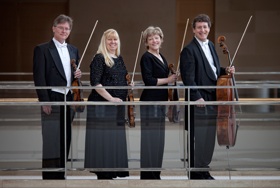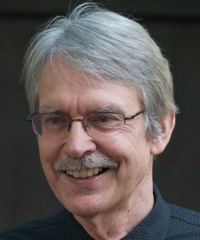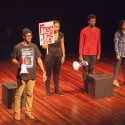Harbison, Haydn and Franck close UW Pro Arte Quartet centennial season
To American composer John Harbison, the string quartet is a malleable model that deserves creative exploration.
Harbison’s String Quartet No. 5 — commissioned by the UW Pro Arte Quartet as the fourth and final work to celebrate its 100th anniversary season — takes both the composer and his musical muse in new and unusual directions.

The Pro Arte Quartet is made up of, from left, violinist David Perry; violinist Suzanne Beia; violist Sally Chisholm; and cellist Parry Karp. (Photo: Rick Langer)
“I had already written four string quartets and I wanted to do something different,” says Harbison, a recipient of the prestigious MacArthur Foundation’s genius award, the Pulitzer Prize and the Heinz Award in the Arts and Humanities. “I fell into the idea of writing 10 short movements, which is not something I’ve done with past string quartets.”
Harbison’s unusual composition will receive its world premiere performance by the Pro Arte on Saturday, April 21, at Mills Concert Hall in the Mosse Humanities Building on the UW–Madison campus. The 8 p.m. concert, which closes Pro Arte’s centennial season, is free and open to the public.
To view and hear the quartet in performance in an earlier concert, click here.
The April 21 concert will be preceded by a free 3 p.m. lecture at the Chazen Museum of Art, 750 University Ave., entitled “Four Famous Belgians: The Quatuor Pro Arte” by noted classical music journalist Tully Potter. Events include a 5 p.m. dinner also at the Chazen (details and reservations at http://www.uniontheater.wisc.edu or 608-265-ARTS ) and a free 7 p.m. concert preview discussion featuring both the composer and the lecturer at Mills Concert Hall.
The centennial season’s closing concert also includes Haydn’s String Quartet in C Major, Op. 54, No. 2, Hob.III:57, and Franck’s String Quartet in D Major, M. 9. Harbison’s love of Haydn led him to suggest that this particular work by the Austrian composer be included in the program, while the Franck work is unique in that it was the Belgian composer’s only string quartet.
Harbison, 73, was introduced to Pro Arte as a boy growing up in Orange, N.J., hearing an earlier iteration of the group perform Schubert’s String Quartet No. 14, D. 810. Viennese violinist Rudolph Kolisch, then leader of Pro Arte, went on to become a mentor and primary influence to Harbison and his wife, violinist Rose Mary Harbison. Kolisch’s words of praise — “progressive, advanced” — colored Harbison’s career as an operatic and symphonic composer, finding their way into the tonalities and unusual structure of the 10-movement String Quartet No. 5.
“Many of these movements were much longer when they started out,” says Harbison. “I retained the parts of each that were closest to the movement’s central theme.”

Harbison
The collection of movements are bookended by the lyrical “Melodia 1” and “Melodia 2,” and include three “scherzinos,” two “notturinos,” one “Visi” (meaning “faces”), one “Cuori” (meaning “hearts”) and ending with “Ripensamento,” a movement designed to tie the entire work together.
The composition replicates in structure the Leonard Stein Anagrams, a piano work Harbison composed about the same time in honor of the late Leonard Stein, composer Arnold Schoenberg’s former personal assistant and former head of the Arnold Schoenberg Institute in Los Angeles.
Stein had previously appeared at the Token Creek Music Festival, the annual end-of-summer concert series the Harbisons host each year on their family farm northeast of Madison. Stein’s predilection to turn his own name into anagrams inspired Harbison’s short-movements approach to the piano work, which he then carried over to the string quartet.
“Harbison’s String Quartet No. 5 is a very unique form,” says Pro Arte cellist Parry Karp. “There are lots of duets scattered throughout. It’s going to be a magical work.”
For Harbison, the composition takes the discipline of string quartets in new directions, which was his initial goal. He hopes the audience will find it appealing and memorable.
“I’d like at least some of them to be haunted by something they hear in the work,” Harbison says. “I’d like something they remember the next day or the day after that to bother them, like some sort of afterimage that keeps returning.”
Karp agrees both with Harbison’s goal and the likely impression the composition will make on concertgoers.
“I think the audience will find it to have an immediate appeal and will want to hear it again,” says Karp. “I also think it’s a piece that Pro Arte will want to play a lot.”
The Quatuor Pro Arte of Brussels, founded in 1911-12, was performing at the Wisconsin Union Theater on the UW campus on May 10, 1940, when Belgium was overrun and occupied by Nazi forces, turning three of its original four musicians into war orphans. By October of that year, the group had officially become the UW Pro Arte Quartet, making it the first university artist ensemble-in-residence in the U.S. That academic affiliation became a business model for most other quartets around the world.
In addition to Karp, current musicians in the Pro Arte, believed to be the world’s oldest continuously performing string quartet and the first quartet anywhere to enjoy a university ensemble-in-residence status, include violinists Suzanne Beia and David Perry, and violist Sally Chisholm.
– By Michael Muckian
Tags: arts, events, School of Music

